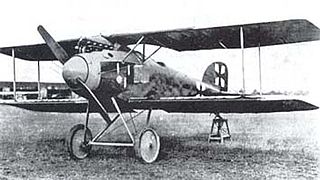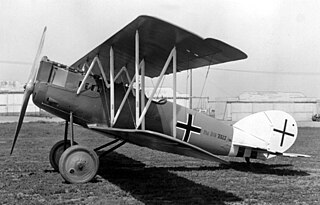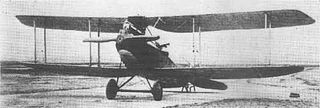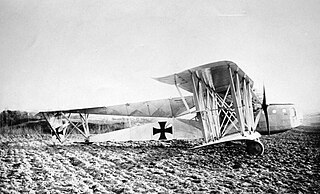
The Albatros D.II was a German fighter aircraft used during World War I. After a successful combat career in the early Jagdstaffeln, it was gradually superseded by the Albatros D.III.

The Pfalz D.XII was a German fighter aircraft built by Pfalz Flugzeugwerke. Designed by Rudolph Gehringer as a successor to the Pfalz D.III, the D.XII entered service in significant numbers near the end of the First World War. It was the last Pfalz aircraft to see widespread service. Though the D.XII was an effective fighter aircraft, it was overshadowed by the highly successful Fokker D.VII.

The LFG Roland D.I was a fighter aircraft produced in Germany during World War I. It was a single-seat aircraft based originally on the Roland C.II two-seat reconnaissance type. It shared its predecessor's unusual design feature of having a deep fuselage that completely filled the interplane gap, but in comparison, the fuselage was much sleeker. While the C.II's appearance had earned the Walfisch ("Whale"), the D.I became known as the Haifisch ("Shark"). The I-struts that had been used to brace the C.II's wing were replaced by more conventional struts. Other changes to the wing included the removal of stagger from the design and the introduction of slight sweepback.

Imperial German Navy seaplanes numbers 1105 and 1106 were the only examples of a unique design produced for the navy's flying service during the First World War. They were unarmed biplanes of conventional configuration with staggered wings of unequal span. The empennage included a sizable ventral fin. Intended as training aircraft, the pilot and instructor sat in tandem, open cockpits. The undercarriage consisted of twin pontoons. The interplane strut arrangement was remarkable for its day, consisting of N-struts and V-struts without any rigging wires.
Imperial German Navy seaplane Number 945 was the sole example of a unique seaplane design produced during the First World War. Throughout the war, the Kaiserliche Werft Wilhelmshaven had been producing small numbers of training seaplanes for the German Navy, but as the conflict continued, they built a small number of armed types as well, including Number 945. While the general layout of this aircraft was conventional enough for its day, it included a number of unusual features. The single-bay wings were braced with single, large I-struts, and the vertical stabiliser was virtually non-existent, consisting of little more than a stub on the dorsal side of the rear fuselage. The rudder was hinged to the end of the fuselage and hung down below it. The Navy classified it as a C3MG type; indicating armament with both fixed and trainable machine guns.

The Rumpler B.I was a military reconnaissance aircraft produced in Germany during World War I.

The Rumpler C.III was a biplane military reconnaissance aircraft built in Germany during World War I.

The Rumpler C.VII was a military reconnaissance aircraft built in Germany during World War I. It was developed from the C.IV and optimised for high-altitude missions that would allow it to operate at heights that would render it immune to interception by enemy fighters. Work on the C.VII took place after a similar attempt to develop the C.III into a high-altitude machine as the C.V failed.

The Rumpler G.I was a bomber aircraft produced in Germany during World War I, together with refined versions known as the G.II and G.III.
The Siemens-Schuckert R.I was a bomber aircraft built in Germany during World War I. It was originally ordered as the Siemens-Schuckert G.I prior to the German Inspectorate of Flying Troops adopting the "R" classification for multi-engine aircraft in late 1915. Some sources refer to the aircraft as the Siemens-Schuckert Steffen R.I, including the name of the brothers that designed it.
The Siemens-Schuckert R.III was a prototype bomber aircraft built in Germany during World War I. It was one of six aircraft based on the Siemens-Schuckert R.I that were originally intended to be identical, but which each developed in a different direction and were designated as different aircraft types by the German Inspectorate of Flying Troops. The aircraft's development was impeded by the unreliability of its Maybach HS engines, and when it was eventually accepted for military service, it was only in a training role.
The Siemens-Schuckert R.V was a bomber aircraft built in Germany during World War I. It was one of six aircraft based on the Siemens-Schuckert R.I that were originally intended to be identical, but which each developed in a different direction and were designated as different aircraft types by the German Inspectorate of Flying Troops. Development of the R.V benefited from the experience that Siemens-Schuckert and the Idflieg had gained with the R.II, R.III, and R.IV, particularly in its choice of powerplants, where the R.V was spared from the troublesome Maybach HS engine. Between September 1916 and February 1917, the aircraft saw service on the Eastern Front before it was damaged in an accident and dismantled for spare parts.

The Siemens-Schuckert R.VI was a bomber aircraft built in Germany during World War I. It was one of six aircraft based on the Siemens-Schuckert R.I, which were originally intended to be identical. Each developed in a different direction and were designated as different aircraft types by the German Inspectorate of Flying Troops.

The Siemens-Schuckert R.VII was a bomber aircraft built in Germany during World War I. It was one of six aircraft based on the Siemens-Schuckert R.I that were originally intended to be identical, but which each developed in a different direction and were designated as different aircraft types by the German Inspectorate of Flying Troops.

The Albatros C.IX was a two-seated German military reconnaissance biplane from 1917. It was built by Albatros Flugzeugwerke. It did not have a central strut between the upper wing and the fuselage, which was uncommon during the time. Also unusual was that the top wing was swept, while the lower wing was straight. Only three of these aircraft were built.

The Siemens-Schuckert D.VI was a single engine, single seat, parasol wing German fighter aircraft flown in 1919.

The LFG Roland D.XV was a World War I German single seat fighter aircraft, ordered as a test-bed for engine comparisons. It was distinguished from earlier Roland biplane designs by the elimination of flying wires. Two later aircraft, also called LFG Roland D.XV, were completely different designs with slab sided fuselages.

The LFG Roland D.XVI, initially designated the LFG Roland E.I, was a single-seat, single-engine, parasol wing German fighter aircraft flown close to the end of World War I. Only two were built.

The LFG Roland G.I was a large prototype single-engine biplane bomber built in Germany in 1915, during World War I. It had a single engine buried in the fuselage driving pusher configuration propellers mounted on outriggers.
The Rumpler C.IX was a German single-engine, two-seat reconnaissance biplane of World War I.















